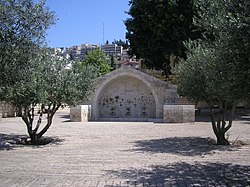|
Mary's Well  Mary's Well (Arabic: عين العذراء, ʿAin il- ʿadhrāʾ or "The spring of the Virgin Mary") is reputed to be located at the site where, according to one Christian tradition associated with the apocryphal Gospel of James, Archangel Gabriel appeared to Mary, mother of Jesus and announced that she would bear the Son of God – an event known as the Annunciation. It has been further associated in the past with episodes from another apocryphal infancy gospel, the Infancy Gospel of Thomas.[1] Found just below the Greek Orthodox Church of St Gabriel in modern-day Nazareth, dedicated to the Annunciation, the well was until recently fed by an aqueduct connected to a spring, and served for centuries as a local watering hole for the Palestinian villagers. Rebuilt twice in the 20th century, once in 1967 and once in 2000, the current structure is a symbolic representation of the one that was once in use. According to Fu'ad Farah, "the Orthodox community supported replacing the structure, because then pilgrims and tourists could note that because of its newness it was not a traditional site", the traditional site he meant being the "spring" inside the Orthodox church. To further encourage pilgrims to visit the church, the pipes supplying the well with water were cut while it was being rebuilt.[2] Two, maybe even three sites are popularly known as Mary's Well – the spring underneath the Greek Orthodox Church of the Annunciation, the well structure in the plaza 50 yards to the south of it, and a presumed spring underneath the Basilica of the Annunciation.[3][4][dubious – discuss] This article primarily describes the well structure in the plaza, which has been dry since the 1990s.[5][6] Originally outside the urban center of Nazareth, it was a popular square and meeting place for the Palestinian community in Nazareth until the Nakba,[dubious – discuss] and has become a symbol of the city of Nazareth.[7] In religious textsApocryphal Gospel of James The earliest written source[dubious – discuss] mentioning to a well or spring being the site of the Annunciation comes from the Protoevangelium of James, a non-canonical gospel dating to the 2nd century.[8] The author writes:
Infancy Gospel of ThomasThe Infancy Gospel of Thomas mentions the boy Jesus breaking the jar he was supposed to bring water with from the well, but miraculously carrying the water in his mantle instead.[10] Gospel of LukeThe canonical Gospel of Luke does not mention the drawing of water in its account of the Annunciation. QuranThe Quran records a spirit in the form of a man visiting a chaste Mary to inform her that the Lord has granted her a son to bear, without referencing the drawing of water, but records a stream of water coming up from the ground at her feet when she was giving birth of Jesus in the same passage of the Quran: Surah 19:16-25. History and archaeologyByzantine periodExcavations by Yardenna Alexandre and Butrus Hanna of the Israel Antiquities Authority in 1997-98, sponsored by the Nazareth Municipality and the Government Tourist Corporation, discovered a series of underground water systems and suggested that the site today known as Mary's Well served as Nazareth's main water supply from as early as Byzantine times. Despite having found Roman era potsherds, Alexandre's report claimed hard evidence of Roman-era use of the site was lacking.[11][12] 19th century William Rae Wilson describes "a well of the Virgin, which supplied the inhabitants of Nazareth with water" in his book, Travels in Egypt and the Holy Land (1824).[13]   James Finn, then British Consul in Jerusalem, visited Nazareth in late June 1853 and his company pitched their tents near the fountain, - the only fountain there. He writes that "the water at this spring was very deficient this summer season, yielding only a petty trickling to the anxious inhabitants. All night long the women were there with their jars, chattering, laughing, or scolding in competition for their turns. [ ] It suggested a strange current of ideas to overhear pert damsels using the name of Miriam (Mary), in jest and laughter at the fountain of Nazareth"[15] 20th and 21st centuriesWhile the current structure referred to as Mary's Well is a non-functional reconstruction inaugurated as part of the Nazareth 2000 celebrations,[16] the traditional Mary's Well was a local watering hole, with an overground stone structure. Through the centuries, villagers would gather here to fill water pitchers (up until 1966[dubious – discuss]) or otherwise congregate to relax and exchange news.[17] At another area not too far off,[where?] which tapped into the same water source, shepherds and others with domesticated animals would bring their herds to drink.  Ancient water installationsAmateur as well as professional archaeological work near the well has produced data on ancient water installations including a bath house. The dates are as yet inconclusive, going back to at least the Mamluk period (see article). Bibliography
References
External linksWikivoyage has a travel guide for Nazareth. |